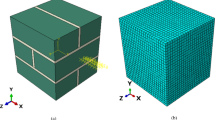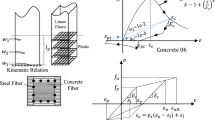Abstract
Recent research showed that the in-plane horizontal displacement capacity of unreinforced masonry (URM) walls depends on numerous factors that are not yet captured by current empirical drift capacity models; e.g., axial stress, shear span, geometry of the walls and the material used. In order to improve the performance-based assessment of URM wall buildings, future research should aim at developing numerical and mechanical models that link the global force-displacement response of URM walls to local deformation measures such as strains. This paper addresses the behaviour of modern clay brick masonry and makes first contributions to such an endeavour by the evaluation of experimental results: first, two sets of limit states are proposed that link local damage limit states to characteristic points of the global force-displacement response of the URM wall. The two sets define limit states for walls developing a shear or a flexural mechanism respectively. Second, local deformation measures deemed suitable for the characterisation of these limit states are evaluated from optical measurement data of quasi-static cyclic wall tests. These include strains, compression zone depth and the ratio of shear to flexural deformations.




















Similar content being viewed by others
References
Abrams DP (2001) Performance-based engineering concepts for unreinforced masonry building structures. Prog Struct Mat Eng 3(1):48–56
ATC (1998) FEMA-306: evaluation of earthquake damaged concrete and masonry wall buildings. Basic Procedures Manual, Applied Technology Council (ATC), Washington
Benedetti A, Benedetti L (2013) Interaction of shear and flexural collapse modes in the assessment of in-plane capacity of masonry walls. In: Proceedings of the 12th Canadian masonry symposium, Vancouver, Canada
Benedetti A, Steli E (2008) Analytical models for shear-displacement curves of unreinforced and FRP reinforced masonry panels. Constr Build Mater 22:175–185
Bosiljkov V, Page A, Žarnič R (2003) Performance based studies of in-plane unreinforced masonry walls. Mason Int 16(2):39–50
Calvi GM (1999) A displacement-based approach for vulnerability evaluation of classes of buildings. J Earthq Eng 3(3):411–438
CEN (2005) Eurocode 8: design of structures for earthquake resistance: part 3: assessment and retrofitting of buildings EN 1998-3:2005. European Committee for Standardisation, Brussels, Belgium
Facconi L, Plizzari G, Vecchio F (2014) Disturbed stress field model for unreinforced masonry. J Struct Eng 140(4). doi:10.1061/(ASCE)ST.1943-541X.0000906
Fehling E, Stuerz J, Emami A (2007) D 7.1a Test results on the behaviour of masonry under static (monotonic and cyclic) in plane lateral loads. Technical report of the collective research project ESECMaSE
Frumento S, Magenes G, Morandi P, Calvi GM (2009) Interpretation of experimental shear tests on clay brick masonry walls and evaluation of q-factors for seismic design. Technical report, IUSS PRESS, Pavia, Italy
Furtmüller T, Adam C (2011) Numerical modeling of the in-plane behavior of historical brick masonry walls. Acta Mech 221:65–77. doi:10.1007/s00707-011-0493-z
Ganz HR, Thürlimann B (1984) Versuche an Mauerwerksscheiben unter Normalkraft und Querkraft. Test report 7502-4, ETH Zürich, Switzerland (in German)
Grünthal G (ed.), Musson R, Schwarz J, Stucchi M (1998) European Macroseismic Scale 1998, Cahiers de Centre Européen de Géodynamique et de Seismologie, vol 15, Luxembourg
Heyman J (1992) Leaning towers. Meccanica 27:153–159
Lagomarsino S, Giovinazzi S (2006) Macroseismic and mechanical models for the vulnerability and damage assessment of current buildings. Bull Earthq Eng 4:415–443
Lagomarsino S, Penna A, Galasco A, Cattari S (2013) TREMURI program: an equivalent frame model for the nonlinear seismic analysis of masonry buildings. J Eng Struct 56:1787–1799. doi:10.1016/j.engstruct.2013.08.002
Lang K (2002) Seismic vulnerability of existing buildings. PhD Thesis, ETH Zürich, Switzerland
Lourenço PB (1996) Computation strategies for masonry structures. PhD Thesis, TU Delft, Netherlands
Lourenço PB, Rots JG (1997) Multisurface interface model for analysis of masonry structures. J Eng Mech 123(7):660–668
Magenes G, Morandi P, Penna A (2008) D 7.1c Test results on the behaviour of masonry under static cyclic in plane lateral loads. Technical report of the collective research project ESECMaSE
Mann W, Müller H (1982) Failure of shear-stressed masonry: an enlarged theory, tests and application to shear walls. In: Proceedings British Ceramic Society, vol 30, pp 223–235
Penna A, Lagomarsino S, Galasco A (2014) A nonlinear macroelement model for the seismic analysis of masonry buildings. Earthq Eng Struct Dyn 43(2):159–179. doi:10.1002/eqe.2335
Petry S, Beyer K (2014) Influence of boundary conditions and size effect on the drift capacity of URM walls. Eng Struct 65:76–88. doi:10.1016/j.engstruct.2014.01.048
Petry S, Beyer K (2014b) Cyclic test data of six unreinforced masonry walls with different boundary conditions. Earthq spectra. doi:10.1193/101513EQS269
Petry S, Beyer K (2014c) Scaling unreinforced masonry for reduced-scale seismic testing. Bull Earthq Eng. doi:10.1007/s10518-014-9605-1
Priestley MJN, Calvi GM, Kowalsky MJ (2007) Displacement-based seismic design of structures. IUSS Press, Pavia
Pfyl-Lang K, Braune F, Lestuzzi P (2011) SIA D 0237: Evaluation de la sécurité parasismique des bâtiments en maçonnerie. Documentation SIA D 0237 (in French). Swiss society of engineers and architects (SIA), Zürich, Switzerland
Tomaževič M (2007) Damage as a measure for earthquake-resistant design of masonry structures: Slovenian experience. Can J Civ Eng 34(11):1403–1412
Zhang S, Petry S, Beyer K (2014) Investigating the in-plane mechanical behavior of URM piers via DSFM. In: Second European conference on earthquake engineering and seismology, Istanbul, Turkey
Acknowledgments
The authors would like to thank the three reviewers for the helpful comments, Morandi Frères SA for the donation of the bricks and the staff of the structural engineering laboratory at EPFL for the support during testing.
Author information
Authors and Affiliations
Corresponding author
Rights and permissions
About this article
Cite this article
Petry, S., Beyer, K. Limit states of modern unreinforced clay brick masonry walls subjected to in-plane loading. Bull Earthquake Eng 13, 1073–1095 (2015). https://doi.org/10.1007/s10518-014-9695-9
Received:
Accepted:
Published:
Issue Date:
DOI: https://doi.org/10.1007/s10518-014-9695-9




